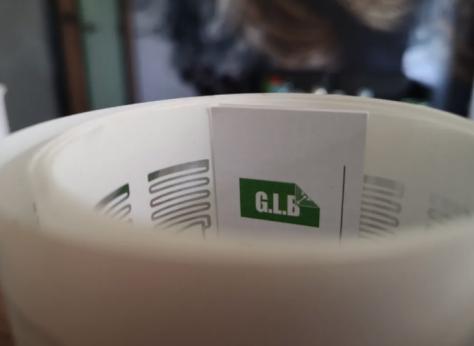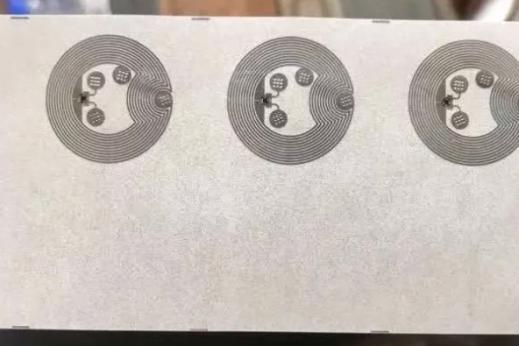Our country's RFID industry entered a cultivation period as early as 2004, and entered a mature period in 2015. At present, a complete upstream and downstream industrial chain has been formed, and it is in a golden period of industrial upward development. The sudden outbreak of the new crown epidemic in 2020 will undoubtedly have a direct impact on the growth of the RFID industry in its golden age. As of today, what is the development trend of
RFID smart labels in the post-epidemic era? In this article, the author expresses his own views based on years of observation and thinking about the RFID industry, hoping to give readers some reference.
01 After the "lack of cores" of RFID chips, it is bound to be the day when domestic products will emerge
From the end of 2020 until today, the RFID industry is the most troubled by the "lack of core" problem. It is understood that for manufacturers upstream of the RFID chip and module supply chain, as soon as they receive a call recently, it is mostly a problem of customers urging the delivery date, but at the moment, there is really no way to give customers a satisfactory answer. This also makes some of the projects that customers are implementing or are preparing to start because of the lack of chip protection, which greatly affects the progress of the project. 1. The "lack of core" dilemma in the RFID industry once presented a confused situation. In fact, the "lack of cores" in the RFID industry is just a corner of the "lack of cores" in the entire semiconductor industry. It can be seen that the shortage of chip production capacity in the semiconductor industry has continued from the end of last year to the present, and there is still no sign of getting rid of this predicament. The current chaotic situation is the result of the superposition of multiple factors.

Paper RFID smart label
For the RFID industry, in addition to the reasons mentioned above, there are also influences from the internal conduction of the semiconductor industry. Since the “lack of cores” is a common problem faced by all walks of life at present, in the case of foundry production capacity is tight, the production of RFID chips will also suffer a run on the production schedule of chips from automobiles, consumer electronics, etc., and the production capacity will naturally become more tight. . From the demand side, it is a different picture: under the influence of the new crown epidemic, the home economy has accelerated the global digital transformation, and the various demands carried by cloud services have seen large-scale growth, which further opened up the market demand for RFID smart tags. In addition, with the help of 5G applications, the volume of information circulating around the world has grown substantially, and these growth require more IC and memory entities as support. For this reason, in the case of tight chip supply, in order to ensure the normal operation of the company, companies led by large manufacturers have started the chip "hoarding" model, which in turn drove the entire industry to "hoard" and once again magnified the market. Panic. As one of the industries with the strongest global collaboration effect, the semiconductor industry chain is too complex, and the external environment is full of variables, and there are too many unpredictable uncertainties. In addition, due to the short development history of the domestic semiconductor industry and strong external dependence, the chip supply chain has a very serious risk of "chain-breaking", so we have to maintain a high degree of vigilance.
At the end of 2020, the author had in-depth exchanges with several veterans in the RFID industry on the issue of "shortage of cores". At that time, the RFID industry was not greatly affected by the shortage of chips. optimism. Nowadays, everyone basically thinks that the shortage of chips will not only happen in the next few months or half a year, but it is likely to last for about a year or even longer. Not long ago, TSMC CEO Wei Zhejia also publicly stated in the media that the global chip shortage may continue until 2022. 2. Opening of the development window, continuous breakthroughs in RFID domestic chip technology
Although the RFID industry is trapped by the "lack of cores", it has brought a vigorous vitality to the development of domestic RFID chips. In recent years, there have been many good news about domestic RFID chips. Domestic chip manufacturers including Kunrui, Fudan Micro, BGI, Kailuwei, Guoxin Internet of Things, Zhihuixinlian, Feiju, etc. have launched independent The research and development of tag chips or reader-writer chips has formed a strong momentum of chip localization.

Paper RFID smart label
RFID chips are showing a trend of localization, and there are many favorable factors to stimulate, including market acceptance, policy support, and technological breakthroughs. Specifically: First, the domestic market demand continues to grow, and all walks of life are improving the level of digitization, which can be seen from the annual increase in RFID tag shipments; second, in the context of foreign technology blockades, the country Strong support for chip localization, including the introduction of long-term tax exemption policies, financial support, etc.; third, compared with more integrated chips such as mobile phones, computers, and automobiles, RFID chips are relatively less difficult to develop and can achieve faster results field of. In addition, as many RFID projects involve national security management and control requirements, the necessity for localization of RFID chips has been further strengthened. From the perspective of the market, it is easy to see the presence of domestic chips in some important application projects. For example, on March 9, 2021, Air China began to use domestic RFID chip baggage tags on Chongqing-Wuhan round-trip, Chongqing-Beijing and Wuhan-Beijing (one-way) routes. This is the basis for Air China's full-process passenger baggage tracking service opened in 2020 Another breakthrough in the above is also the first time that Air China has used domestic RFID chip baggage tags on domestic routes. 3. Continuous breakthroughs in domestic chip technology are conducive to the long-term development of the RFID industry. According to statistics from the Financial Times, China’s chip manufacturing capacity has increased from almost a blank to 15% in the 20 years from 2000 to the present, and it is expected to increase in 2030. Increase to 24%. In 2020, the number of equity investment cases in the domestic semiconductor industry reached 413, with an investment amount of more than 140 billion yuan. Compared with the investment amount of about 30 billion yuan in 2019, it has increased by nearly four times. This is also the largest investment amount in the history of China's semiconductor primary market. One year, effectively promoted the vigorous development of domestic chip companies. In addition, as the digitalization process of the domestic industry has begun to enter a new stage of development, the importance of RFID has become more prominent. Taking the application of baggage traceability in the aviation industry as an example, according to the plan of the Civil Aviation Administration, the whole process of baggage tracking will be achieved on domestic routes between tens of millions of airports across the country by the end of 2021, and full coverage of domestic routes and breakthroughs in international routes will be achieved by the end of 2025. In the short term, under the current special conditions, the timely supply of domestic RFID chips can alleviate the serious shortage of chips in the current market, allowing existing projects to operate normally, and also allowing new projects to go online as scheduled. In the long run, the localization of RFID chips will help the domestic industrial chain continue to improve, and the price of chips will continue to decrease, which will help increase the market's acceptance of RFID, make the application market bigger, and promote the long-term development of the RFID industry.

Paper RFID smart label
We have reason to believe that with the wisdom of the Chinese people, the advantages of the nationwide system, and the support of the manufacturing industry in the world’s first industrial country, the RFID "core shortage" predicament can not only be resolved through localization within a few years, but we must worry about preventing chip domestic production. The problem of overcapacity after transformation, because this may be another high-tech artifact in the West being pulled from the altar by the Chinese people and entering the historic stage of stalling the price of cabbage.
02 Smart tags compatible with "RFID+" sensor functions are emerging
The rapid development of my country in the past few decades mainly relied on the advantages of cheap labor costs and industrial chain clusters. However, with the rapid rise of my country’s economy in recent years, it has been regarded as a strategic competitor by western developed countries, so it will be in many fields in the future. It will present a situation of fierce competition in multiple directions. Among them, high and new technology is bound to bear the brunt and become the main battlefield of various countries' wrestling. It is foreseeable that in the next five years, more RFID technology companies will continue to increase R&D investment and strengthen research on cutting-edge technologies. In the future, sensor technology and RFID information technology will gradually be deeply integrated, and smart tags compatible with "RFID+" sensor functions will emerge. The smart label compatible with the "RFID+" sensor function has a broad application imagination. It can be equipped with various different types of sensors, such as temperature and humidity, torque, resistance, three-axis acceleration, pressure sensor, and LED according to the needs of the scene. In addition, in some scenarios that require real-time monitoring, such as tires, smart agriculture, smart medical care, manufacturing, smart assets, high-speed rail aircraft, etc., it can also give full play to its advantages. Because the "RFID+" sensor function smart tag can work in a passive power supply mode, in some specific scenarios, passive measurement and control can be used to replace active measurement and control. For example, in the power distribution cabinet, battery-equipped tags cannot be used to measure temperature, because this will bring great potential dangers, and battery-less sensor tags are very suitable for this scenario. Passive tags are easy to install and do not need to spend energy on maintenance, which can effectively reduce installation and operating costs. In addition, smart tags with sensing functions can be widely used in industrial application scenarios that need to be monitored but cannot be accessed by humans, such as the automation of automobile assembly lines, and temperature monitoring in motors and generators. At present, smart tags with sensor functions have been used in aero engines of Safran Group in France. Equipped with a torque sensor, the sensor function smart tag can accurately monitor the torque of the screw. The slight loosening of a screw may seem inconspicuous, but it actually involves the lives of millions of people. Nowadays, RFID smart tags with sensing functions have been used in NASA projects. In fact, the combined application of RFID technology and sensors is far more than that. Sensing smart tags can enable new applications such as cold chain monitoring, smart management, and traceability to achieve precise monitoring of the temperature of perishable products; passive RFID weight sensors can be used to monitor particles and liquids calculated based on weight Inventory of other assets and other assets; smart tags with sensing functions for measuring temperature and humidity also have many applications in agriculture.

Paper RFID smart label
All in all, with the advancement of digital applications and the integration of technology, the relationship between
RFID smart tags compatible with sensor technology and the Internet of Things will become closer. At the same time, since the sensor market is much larger than the RFID market, this will also be the direction for the RFID market to continue to develop. It is worth thinking about, for the research and development of smart labels with sensor functions, the future direction of research and development should focus more on how to achieve high-sensitivity, high-precision sensor integration, and how to control costs.
03 Innovative RFID smart tags are changing people's lives
When you are choosing fresh products, there may be some doubts, such as what is the shelf life of the product, what is the source and processing of each milk on the shelf, and even what kind of meat or salmon is the most nutritious... these are in us In the familiar conventional tags, you will only see some basic information about the product. Think about it, if you turn the conventional tags into interactive smart tags, what will the scenario look like? Interactive smart tags can be realized immediately when you scan By accessing further information, you can know the origin, breed, year of birth, or the factory where it will be processed into beef. You can even track the production schedule, know where the beef comes from, what happened in the transportation process, and the quality , Taste and even our health is not affected, etc. Throughout the production process, this technology can change consumer behavior, which will help everyone choose products more carefully and easily. Based on the obvious traceability of RFID smart tags, the emergence of the epidemic has accelerated the popularization of RFID smart tags in food and medicine. For example, SIC proposed including NFC forum type2 tag IC and RF/tamper detection-SIC43NT and NFC forum type2 tag IC and AES-128-based security-SIC43S1, which effectively supports the innovative application of smart tags. In addition, there is a company called Shanghai Feiju, which is also very characteristic in NFC anti-cloning. These innovations actively respond to the growing needs of consumers.

Paper RFID smart label
04 Natural, clean and high-tech paper RFID smart labels are the future development direction
According to data released by the United Nations Intergovernmental Panel on Climate Change (IPCC), if high-temperature gas emissions are maintained, the global sea level will rise by 1.1m by 2100 and by 5.4m by 2300. With the acceleration of climate warming, the frequent occurrence of extreme weather conditions, and the intensification of environmental pollution, the international community has paid more and more attention to environmental protection issues, and has continuously introduced policies to reduce the negative impact of economic development on the environment. Natural, clean and high-tech
paper RFID smart labels have become the new development direction of the RFID industry. Paper-based RFID smart label technology can directly print RFID antennas on renewable wood fiber substrates without using any plastics, can achieve 100% recyclability and biodegradability, and can help brand owners significantly reduce about 40% Carbon emission is a veritable green environmental protection RFID label product. In addition, paper RFID smart tags can also be embedded in product packaging, which can more effectively prevent information tampering. As an international brand operation group integrating design, creativity, production and sales, Ribo Group has used RFID paper biodegradable smart tags to replace its traditional RFID smart tags for new apparel products in the spring and summer of 2020, aiming at women's wear The industry builds its sustainable brand image. It is reported that Ribo Group has used a total of about 5 million RFID paper degradable smart tags this time, which is equivalent to reducing the use of plastic by 1.66 standard football fields each year, successfully reducing carbon by about 12,000 kg. In fact, the paper-based aluminum antenna RFID tag technology developed by Wenzhou Globo Electronics Co., Ltd. and Stora Enso's ECO RFID tag technology can provide ideal choices for companies that strive to fulfill the promise of biodegradability. Huang Xingbo, general manager of Wenzhou Global Electronics Co., Ltd. once said: "The launch of paper-based antenna RFID smart tags has opened up a truly sustainable development path for our customers and consumers, and has accelerated the use of RFID in renewable solutions. The application of smart technology." By combining RFID technology with paper labels, the manufacturing process can be made more flexible, cost-effective, and performance and reliability can be compromised. In addition, RFID smart tags can be recycled together with paper and cardboard materials, which is very environmentally friendly. At present, this technology has been applied to a number of ongoing cross-domain cooperation projects.





